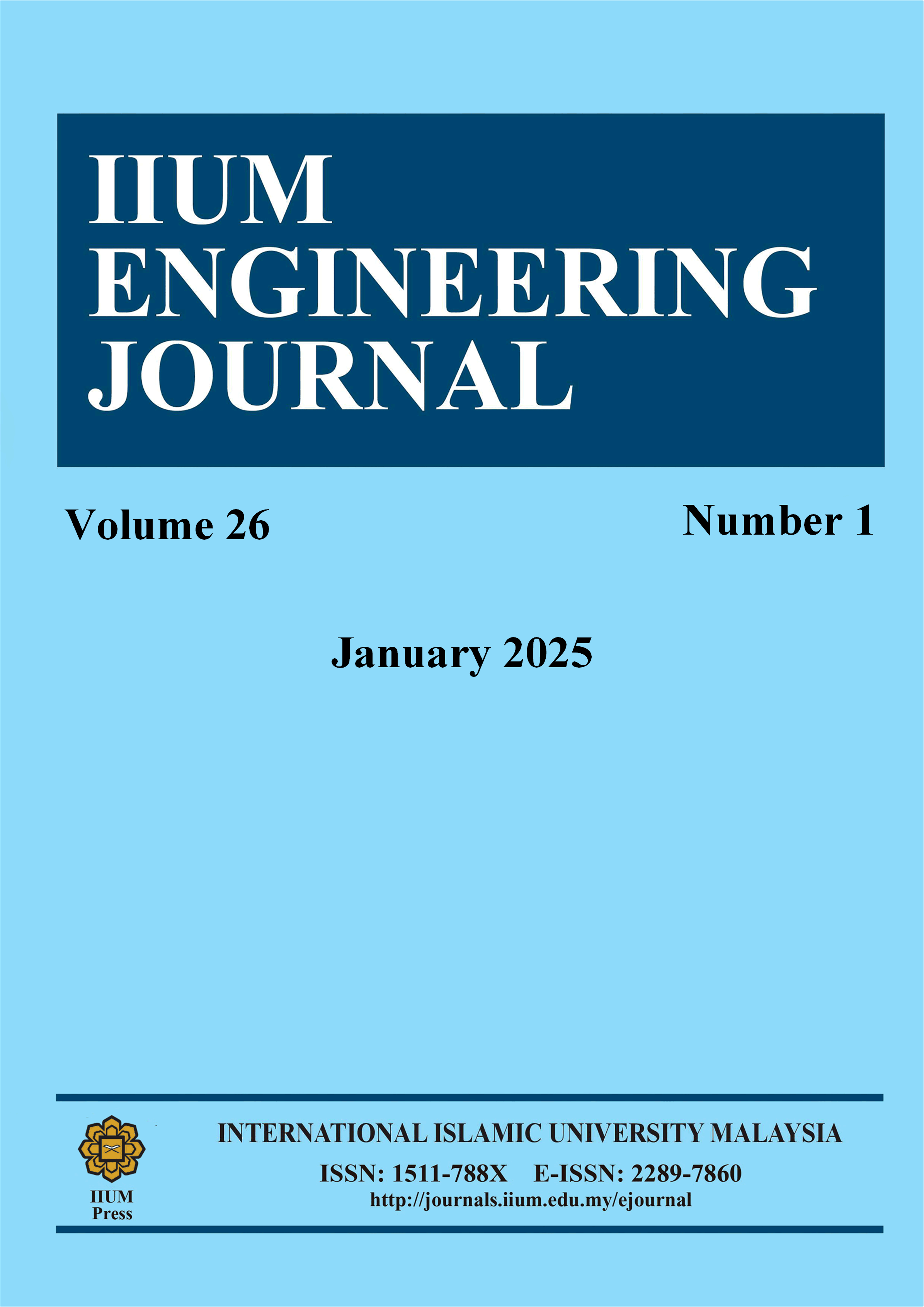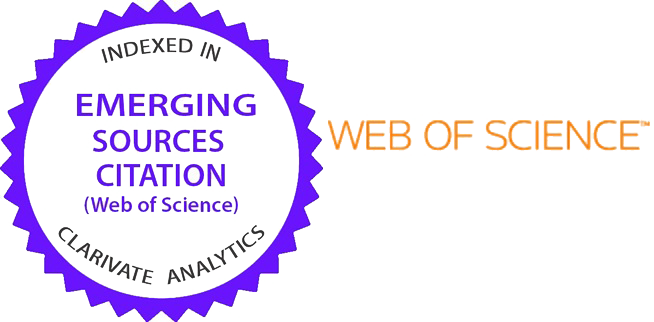Integration of LoRa IoT with Cloud Platform in a Stingless Beehive Remote Monitoring System
DOI:
https://doi.org/10.31436/iiumej.v26i1.3531Keywords:
LoRa SX1278, ESP32, Remote monitoring, BME680, UbidotsAbstract
Stingless bee colonies require constant monitoring to ensure hive health and optimal honey production. However, conventional monitoring practices are time-consuming and labor-intensive, especially for beekeepers in rural or remote areas. Without access to real-time hive data, beekeepers may struggle to detect changes in temperature, humidity, and other vital conditions that could impact bee health and productivity. Most studies rely on Wi-Fi modules for communication between local and cloud servers. However, using Wi-Fi for bee monitoring requires that the stingless bee hives be located near buildings with Wi-Fi access. To address this issue, a prototype of a remote monitoring system for a stingless bee colony was developed using Long Range (LoRa) technologies due to the low data rate, low power, and operability in an outdoor environment. This system aims to help beekeepers monitor the beehives remotely. The prototype comprises two nodes: a beehive sensor node and a LoRa gateway node. The beehive monitoring sensor node is equipped with the ESP32 as a microcontroller, LoRa SX1278, BME680, and KY-037. The LoRa gateway comprises ESP32 and LoRa SX1278 and is interfaced with Ubidots through Node-Red. The developed prototype was tested at four locations at varying distances in the Mahallah Ruqayyah Kelulut farm. The result shows that LoRa is feasible for remote monitoring because it can reliably transmit data up to 58 meters despite a higher data rate. The Ubidots dashboard displays the temperature, humidity percentage, air quality, pressure, sound levels, and RSSI value for thorough insights into the bee's condition, as it can be accessed using web and mobile applications. Overall, the stingless bee remote monitoring system using LoRa communication is a promising solution for outdoor applications between the sender and receiver for data transmission in remote areas.
ABSTRAK: Koloni lebah kelulut memerlukan pemantauan berterusan untuk memastikan kesihatan sarang dan pengeluaran madu yang optimum. Walau bagaimanapun, amalan pemantauan konvensional memerlukan banyak masa dan tenaga, terutamanya bagi penternak lebah di kawasan pedalaman atau terpencil. Tanpa akses kepada data sarang secara masa nyata, penternak lebah mungkin menghadapi kesukaran untuk mengesan perubahan suhu, kelembapan, dan keadaan penting lain yang boleh menjejaskan kesihatan serta produktiviti lebah. Kebanyakan kajian menggunakan modul Wi-Fi untuk komunikasi antara pelayan tempatan dan awan. Walau bagaimanapun, penggunaan Wi-Fi untuk pemantauan lebah memerlukan sarang lebah kelulut diletakkan berhampiran bangunan dengan akses Wi-Fi. Bagi mengatasi isu ini, satu prototaip sistem pemantauan jauh untuk koloni lebah kelulut telah dibangunkan menggunakan teknologi Long Range (LoRa) yang mempunyai kadar data rendah, penggunaan tenaga yang rendah, serta sesuai untuk persekitaran luar. Sistem ini bertujuan membantu penternak lebah memantau sarang lebah dari jauh. Prototaip ini terdiri daripada dua nod: nod sensor sarang lebah dan nod pintu gerbang LoRa. Nod sensor pemantauan sarang lebah dilengkapi dengan ESP32 sebagai mikropengawal, LoRa SX1278, BME680, dan KY-037. Pintu gerbang LoRa pula menggunakan ESP32 dan LoRa SX1278 yang dihubungkan dengan Ubidots melalui Node-Red. Prototaip ini telah diuji di empat lokasi berbeza pada jarak yang berbeza di ladang Kelulut Mahallah Ruqayyah. Hasil menunjukkan bahawa LoRa adalah sesuai untuk pemantauan jarak jauh kerana, walaupun pada kadar data yang lebih tinggi, ia boleh menghantar data dengan baik sehingga jarak 58 meter. Papan pemuka Ubidots memaparkan suhu, peratusan kelembapan, kualiti udara, tekanan, tahap bunyi, dan nilai RSSI untuk memberikan gambaran lengkap mengenai keadaan lebah, yang boleh diakses melalui aplikasi web dan mudah alih. Secara keseluruhan, sistem pemantauan jauh lebah kelulut menggunakan komunikasi LoRa adalah penyelesaian yang menjanjikan untuk aplikasi luar di kawasan terpencil antara penghantar dan penerima bagi penghantaran data.
Downloads
Metrics
References
Heard, T. A. (1999). The role of stingless bees in crop pollination. In Annual Review of Entomology (Vol. 44, pp. 183–206). https://doi.org/10.1146/annurev.ento.44.1.183 DOI: https://doi.org/10.1146/annurev.ento.44.1.183
Lau, I. H., Hereward, J. P., Smith, T. J., Heard, T. A., & Walter, G. H. (2022). Inter-colony fights in Tetragonula stingless bees result in temporary mixed-species worker cohorts. Apidologie, 53(4). https://doi.org/10.1007/s13592-022-00936-3 DOI: https://doi.org/10.1007/s13592-022-00936-3
Grüter, C., von Zuben, L. G., Segers, F. H. I. D., & Cunningham, J. P. (2016). Warfare in stingless bees. In Insectes Sociaux (Vol. 63, Issue 2, pp. 223–236). Birkhauser Verlag AG. https://doi.org/10.1007/s00040-016-0468-0 DOI: https://doi.org/10.1007/s00040-016-0468-0
Miskon, M. T., Razak, M. A. A., Jaafar, H., Hassan, N., & Mahmood, R. (2022). A Lora-based Testbed Development for Stingless Bee Monitoring System. TEM Journal, 11(2), 712–718. https://doi.org/10.18421/TEM112-26 DOI: https://doi.org/10.18421/TEM112-26
Shamsudin, S., Selamat, J., Sanny, M., Abd. Razak, S. B., Jambari, N. N., Mian, Z., & Khatib, A. (2019). Influence of origins and bee species on physicochemical, antioxidant properties and botanical discrimination of stingless bee honey. International Journal of Food Properties, 22(1), 239-264. DOI: https://doi.org/10.1080/10942912.2019.1576730
Ramli, M. F., Harun, A., Ismail, R. C., Ndzi, D. L., Turner, J. S. C., Farook, R. S. M., Isa, M., & Murad, S. A. Z. (2021). Design and development of stingless beehive air pollutant monitoring system. International Journal of Nanoelectronics and Materials (Vol. 14, Issue SI)
Mustafa & Wan Abu Bakar, Wan Aezwani & Razak, Muhammad. (2019). An Intelligent Stingless Bee System with Embedded IoT Technology. International Journal of Recent Technology and Engineering (IJRTE). 8. 264-269. 10.35940/ijrte.C4124.098319. DOI: https://doi.org/10.35940/ijrte.C4124.098319
Tashakkori, R., Hamza, A. S., & Crawford, M. B. (2021). Beemon: An IoT-based beehive monitoring system. Computers and Electronics in Agriculture, 190. https://doi.org/10.1016/j.compag.2021.106427 DOI: https://doi.org/10.1016/j.compag.2021.106427
Ferrari, S., Silva, M., Guarino, M., & Berckmans, D. (2008). Monitoring of swarming sounds in bee hives for early detection of the swarming period. Computers and electronics in agriculture, 64(1), 72-77. DOI: https://doi.org/10.1016/j.compag.2008.05.010
Evans, S.K, (2015) Electronic beehive monitoring-applications to research. 12th International Symposium of the ICP-PR Bee Protection Group, Ghent, Belgium, 2014, pp. 121-129,
N. H. Khairul Anuar et al., "IoT Platform for Precision Stingless Bee Farming," 2019 IEEE International Conference on Automatic Control and Intelligent Systems (I2CACIS), Selangor, Malaysia, 2019, pp. 225-229, doi: 10.1109/I2CACIS.2019.8825089. DOI: https://doi.org/10.1109/I2CACIS.2019.8825089
(pp. 334–342). Atlantis Press International BV. https://doi.org/10.2991/978-94- 6463-082-4_29
E. Ntawuzumunsi and S. Kumaran, "Design and Implementation of Smart Bees Hiving & Monitoring System," 2019 IST-Africa Week Conference (IST-Africa), Nairobi, Kenya, 2019, pp. 1-9, doi: 10.23919/ISTAFRICA.2019.8764856. DOI: https://doi.org/10.23919/ISTAFRICA.2019.8764856
Imoize, A. L., Odeyemi, S. D., & Adebisi, J. A. (2020). Development of a low-cost wireless beehive temperature and sound monitoring system. Indonesian Journal of Electrical Engineering and Informatics, 8(3), 476–485. https://doi.org/10.11591/ijeei.v8i3.2268 DOI: https://doi.org/10.52549/ijeei.v8i3.2268
Rosli, H. A., Malik, N. A., & Ahmad, Y. A. (2022, August). IoT based monitoring system for stingless bees colony in IIUM. In Journal of Physics: Conference Series (Vol. 2312, No. 1, p. 012088). IOP Publishing. DOI: https://doi.org/10.1088/1742-6596/2312/1/012088
Syed Salleh, S. N. A., Mohd Hanapiah, N. A., Ahmad, H., Wan Johari, W. L., Osman, N. H., & Mamat, M. R. (2021). Determination of Total Phenolics, Flavonoids, and Antioxidant Activity and GC-MS Analysis of Malaysian Stingless Bee Propolis Water Extracts. Scientifica, 2021. https://doi.org/10.1155/2021/3789351 DOI: https://doi.org/10.1155/2021/3789351
Downloads
Published
How to Cite
Issue
Section
License
Copyright (c) 2025 IIUM Press

This work is licensed under a Creative Commons Attribution-NonCommercial 4.0 International License.






















